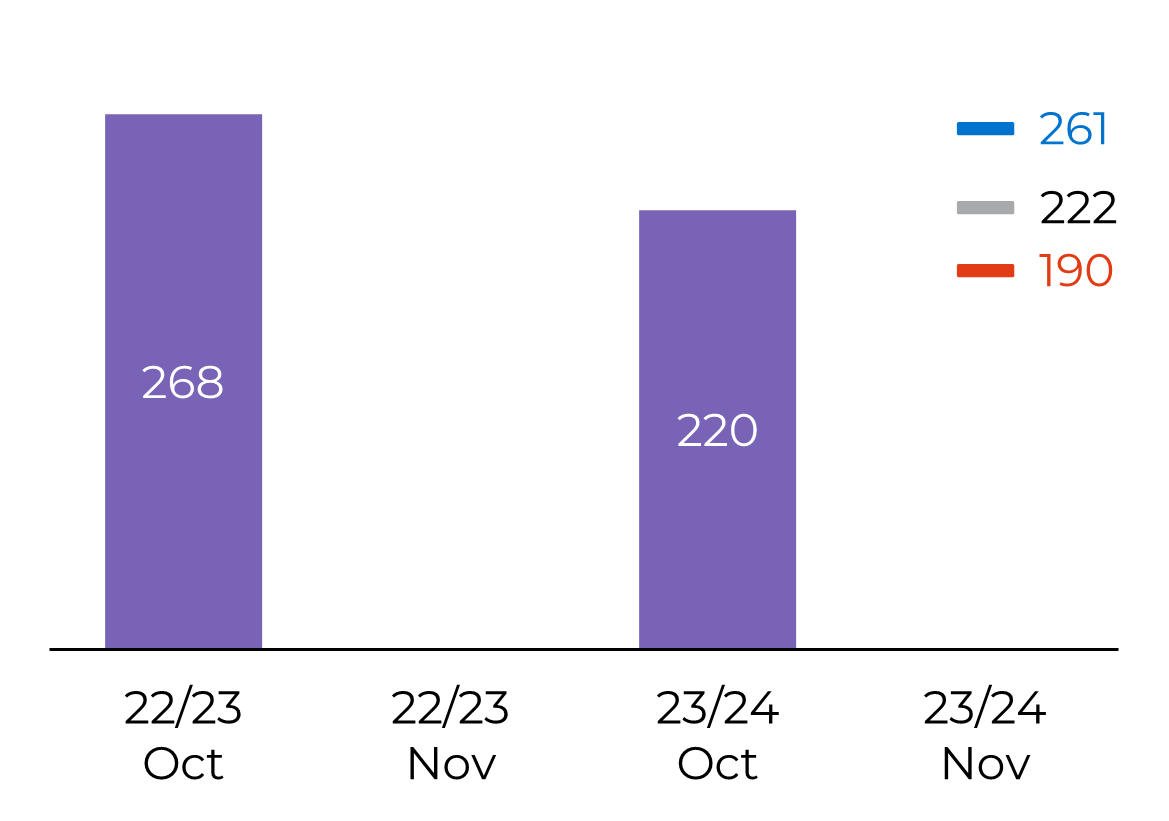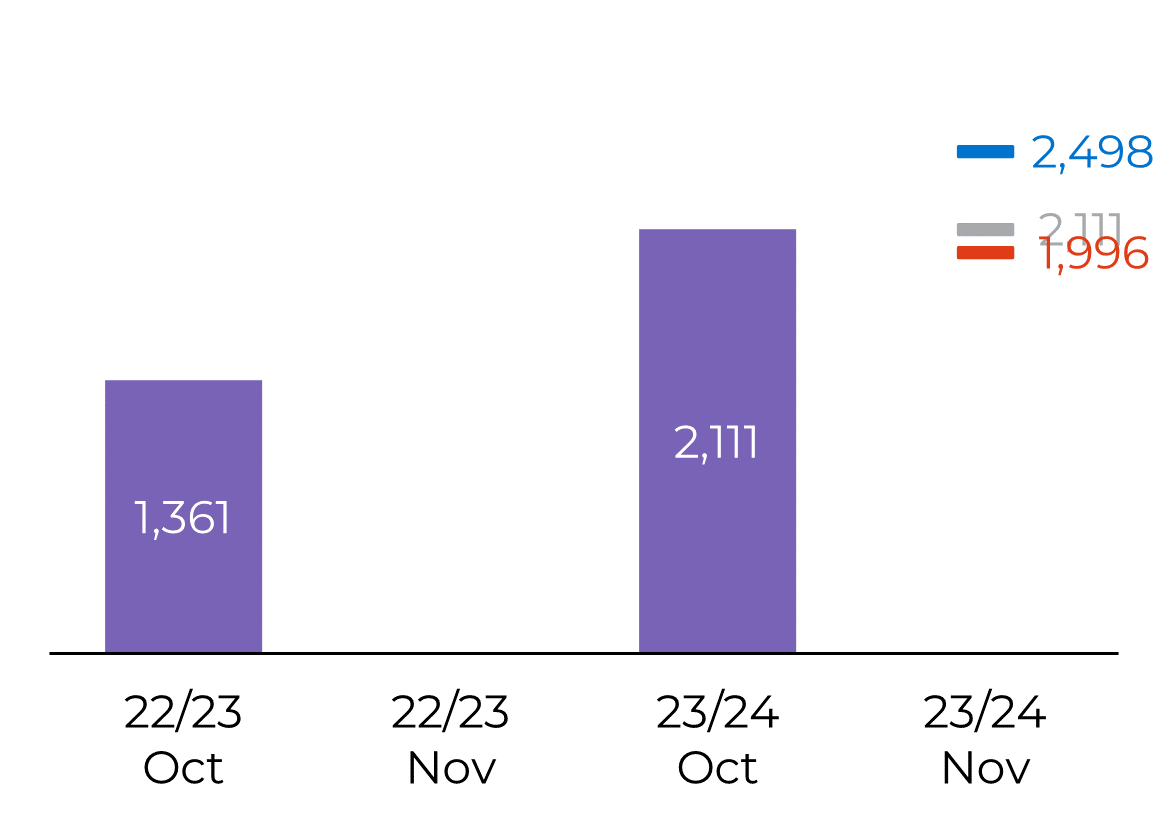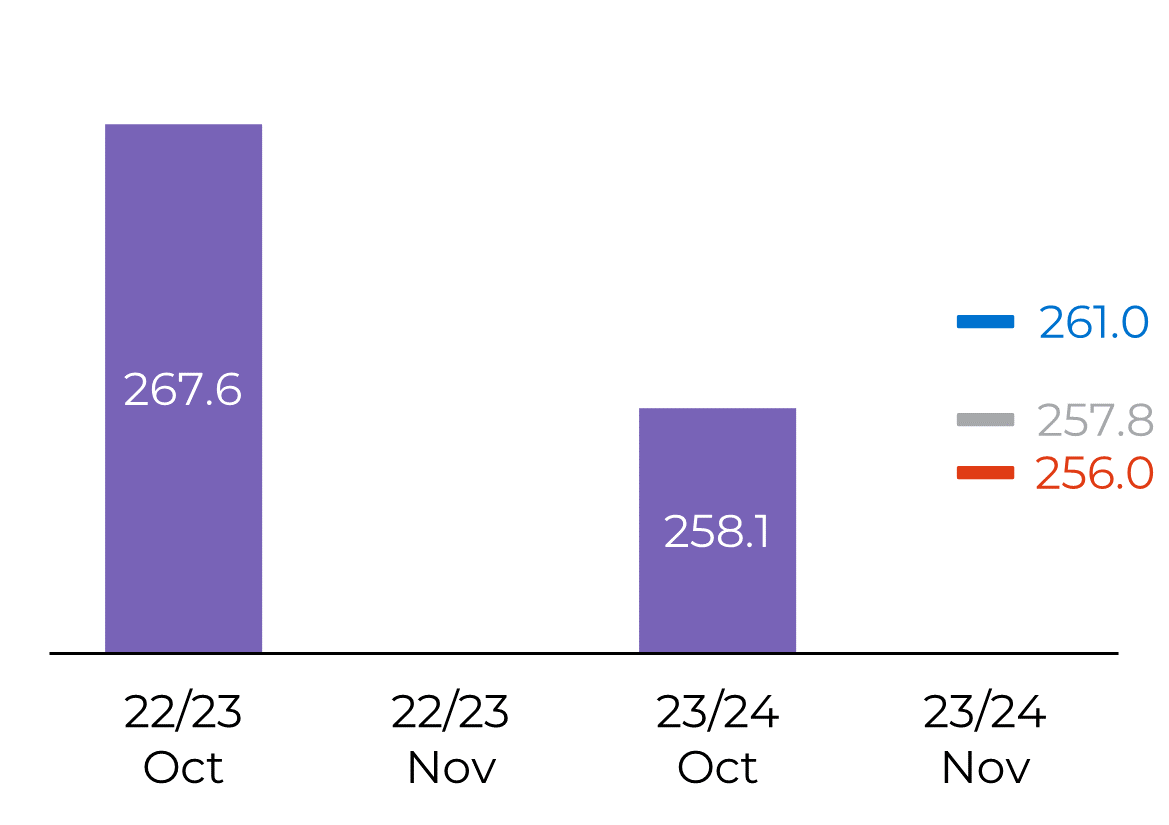
Nov 8
/
Alef Dias e Pedro Schicchi
Pre-WASDE Monthly Report - 2023 11 08
Back to main blog page
"Perspectives for the USDA's November report"
Soybeans: small changes are expected in the US, but what about SA?
Figure 1: US Soybean - Ending Stocks (M bu)

Soybeans are in a transition moment. November marks the end of the adjustments to the US supply side this year. The market expects little change from October, which is valid, given not much has changed since then for the country. However, when the expectations range is narrow, small changes can have a big price impact.
Regarding South America, CBOT prices have already started to reflect the poor weather prospects in Brazil. However, that does not mean that the agency will change its estimates. Over the past 10 years, the USDA only changed Brazil’s production numbers twice in November. Not impossible, but unlikely.
Argentina is a different story. The country’s production was changed in four out of the last six Nov reports. If that’s the case, we expect an increase.
Argentina is a different story. The country’s production was changed in four out of the last six Nov reports. If that’s the case, we expect an increase.
Corn: a similar story
Figure 2: US Corn - Ending Stocks (M bu)

In corn, the scenario is similar. In the last report of the year to change US supplies, the market expects very little variation from October.
When it comes to Argentina, adjustments to production are not as likely as for soybeans, but they also happen. We expect more soybeans and less corn in the country, given the local price and cost scenario.
As for Brazil, the market is already pricing a much smaller 23/24 crop than USDA’s current numbers. However, like for soybeans, changes are not that likely looking at the history
Wheat: world stocks keep getting tighter as dryness reigns in the south
Figure 3: World Wheat - Ending Stocks (M mt)

In wheat, the poor weather scenario for the southern hemisphere crops will likely keep dragging down world ending stocks – and probably more than market is currently expecting.
The market is not expecting much change in the US’ balance, but exporting activity is still very slow, opening space for a cut.
When it comes to Argentina, there’s already a gap of 3M mt between USDA current estimates and the most pessimistic local forecast – the Rosario Exchange just lowered its estimate to 13.5M mt.
For Australia, USDA’s numbers already contemplate a huge drop in yields compared to last season. Nonetheless, Australia recorded the driest October in more than 20 years due to the El Niño. Considering some of the lowest yields in this period, there’s still space for additional cuts to the Aussie output – which could come under 20M mt.
The market is not expecting much change in the US’ balance, but exporting activity is still very slow, opening space for a cut.
Charts Legend

WASDE Commentary — Grains
Written by Alef Dias
alef.dias@hedgepointglobal.com
Written by Pedro Schicchi
pedro.schicchi@hedgepointglobal.com
alef.dias@hedgepointglobal.com
Written by Pedro Schicchi
pedro.schicchi@hedgepointglobal.com
Reviewed by Thaís Italiani
thais.italiani@hedgepointglobal.com
thais.italiani@hedgepointglobal.com
Disclaimer
This document has been prepared by hEDGEpoint Global Markets LLC and its affiliates ("HPGM") exclusively for informational and instructional purposes, without the purpose of creating obligations or commitments with third parties, and is not intended to promote an offer, or solicitation of an offer, to sell or buy any securities or investment products. HPGM and its associates expressly disclaim any use of the information contained herein that may result in direct or indirect damage of any kind. If you have any questions that are not resolved in the first instance of contact with the client (client.services@hedgepointglobal.com), please contact our internal ombudsman channel (ouvidoria@hedgepointglobal.com) or 0800-878-8408 (for clients in Brazil only).
Contact us
hedgepointhub.support@hedgepointglobal.com
ouvidoria@hedgepointglobal.com
Funchal Street, 418, 18º floor - Vila Olímpia São Paulo, SP, Brasil
This page has been prepared by Hedgepoint Schweiz AG and its affiliates (“Hedgepoint”) solely for informational and instructional purposes, without the purpose of instituting obligations or commitments to third parties, nor is it intended to promote an offer, or solicitation of an offer of sale or purchase relating to any securities, commodities interests or investment products. Hedgepoint and its associates expressly disclaim any use of the information contained herein that directly or indirectly result in damages or damages of any kind. Information is obtained from sources which we believe to be reliable, but we do not warrant or guarantee the timeliness or accuracy of this information. The trading of commodities interests such as futures, options, and swaps involves substantial risk of loss and may not be suitable for all investors. You should carefully consider wither such trading is suitable for you in light of your financial condition. Past performance is not necessarily indicative of future results. Customers should rely on their own independent judgement and/or advisors before entering in any transaction.Hedgepoint does not provide legal, tax or accounting advice and you are responsible for seeking any such advice separately.Hedgepoint Schweiz AG is organized, incorporated, and existing under the laws of Switzerland, is filiated to ARIF, the Association Romande des Intermédiaires Financiers, which is a FINMA-authorized Self-Regulatory Organization. Hedgepoint Commodities LLC is organized, incorporated, and existing under the laws of the USA, and is authorized and regulated by the Commodity Futures Trading Commission (CFTC) and a member of the National Futures Association (NFA) to act as an Introducing Broker and Commodity Trading Advisor. HedgePoint Global Markets Limited is Regulated by the Dubai Financial Services Authority. The content is directed at Professional Clients and not Retail Clients. Hedgepoint Global Markets PTE. Ltd is organized, incorporated, and existing under the laws of Singapore, exempted from obtaining a financial services license as per the Second Schedule of the Securities and Futures (Licensing and Conduct of Business) Act, by the Monetary Authority of Singapore (MAS). Hedgepoint Global Markets DTVM Ltda. is authorized and regulated in Brazil by the Central Bank of Brazil (BCB) and the Brazilian Securities Commission (CVM). Hedgepoint Serviços Ltda. is organized, incorporated, and existing under the laws of Brazil. Hedgepoint Global Markets S.A. is organized, incorporated, and existing under the laws of Uruguay. In case of questions not resolved by the first instance of customer contact (client.services@Hedgepointglobal.com), please contact internal ombudsman channel (ombudsman@hedgepointglobal.com – global or ouvidoria@hedgepointglobal.com – Brazil only) or call 0800-8788408 (Brazil only).Integrity, ethics, and transparency are values that guide our culture. To further strengthen our practices, Hedgepoint has a whistleblower channel for employees and third-parties by e-mail ethicline@hedgepointglobal.com or forms Ethic Line – Hedgepoint Global Markets.Security note: All contacts with customers and partners are conducted exclusively through our domain @hedgepointglobal.com. Do not accept any information, bills, statements or requests from different domains and pay special attention to any variations in letters or spelling, as they may indicate a fraudulent situation.“HedgePoint” and the “HedgePoint” logo are marks for the exclusive use of HedgePoint and/or its affiliates. Use or reproduction is prohibited, unless expressly authorized by HedgePoint. Furthermore, the use of any other marks in this document has been authorized for identification purposes only. It does not, therefore, imply any rights of HedgePoint in these marks or imply endorsement, association or seal by the owners of these marks with HedgePoint or its affiliates.

